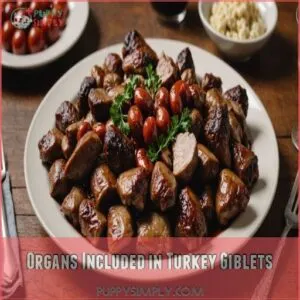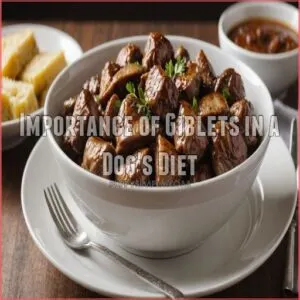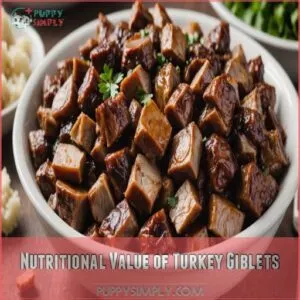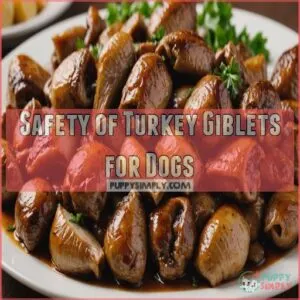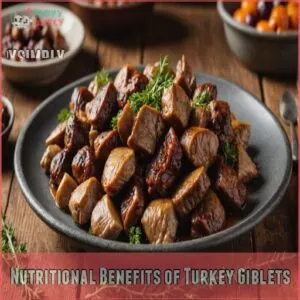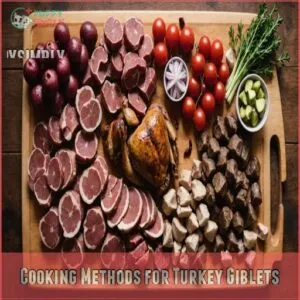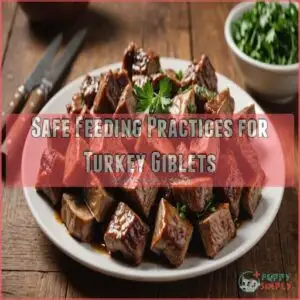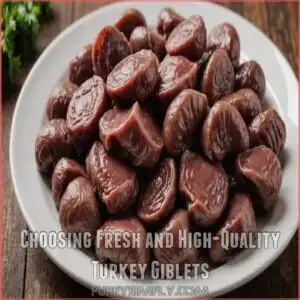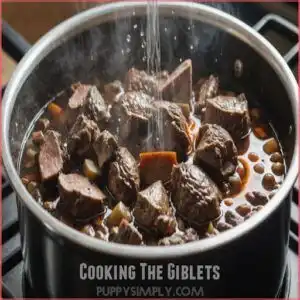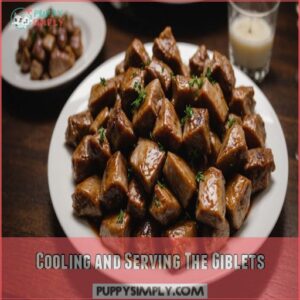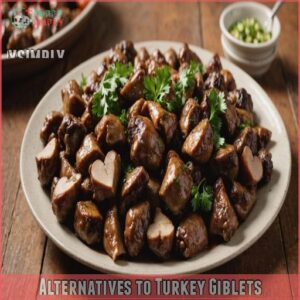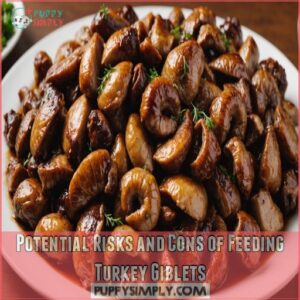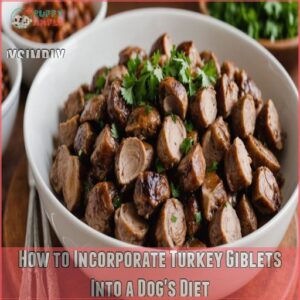This site is supported by our readers. We may earn a commission, at no cost to you, if you purchase through links.
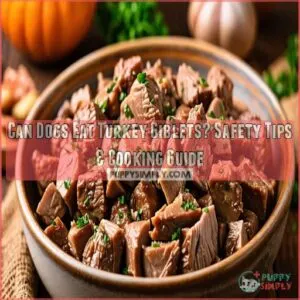
Cook the giblets thoroughly to avoid any tummy troubles.
You might want to skip the neck since it contains bones that could be a choking hazard.
Chop them up for smaller pooches or those with less-than-perfect chompers.
Treat the giblets as an occasional snack, not a main course.
Always watch for signs of allergies or digestive issues—no one likes unexpected clean-up duty!
Next up, we’ll explore some tasty cooking methods and how to serve these nutrient-packed treats safely.
Table Of Contents
- Key Takeaways
- What Are Turkey Giblets
- Safety of Turkey Giblets for Dogs
- Nutritional Benefits of Turkey Giblets
- Cooking Methods for Turkey Giblets
- Safe Feeding Practices for Turkey Giblets
- Storage and Serving of Cooked Turkey Giblets
- Preparing Turkey Giblets for Dogs
- Alternatives to Turkey Giblets
- Potential Risks and Cons of Feeding Turkey Giblets
- How to Incorporate Turkey Giblets Into a Dog’s Diet
- Frequently Asked Questions (FAQs)
- Conclusion
Key Takeaways
- You can feed your dog turkey giblets, but make sure they are cooked thoroughly to prevent bacterial risks. Avoid the turkey neck due to bones that could cause choking.
- Treat giblets as an occasional snack, not a main meal, and ensure they are given in moderation to avoid digestive or health issues.
- Cut giblets into bite-sized pieces, especially for smaller dogs or those with dental concerns, to promote easy digestion and prevent choking.
- Monitor your dog for signs of allergies or digestive problems when introducing giblets into their diet, as some unsafe Thanksgiving foods for dogs can cause severe reactions. Monitor your dog for signs of allergies or digestive problems when introducing giblets into their diet to ensure they tolerate the new treat safely.
What Are Turkey Giblets
Turkey giblets are the edible organs found inside a turkey, including the heart, liver, kidneys, and gizzard, sometimes accompanied by the neck.
They’re often overlooked but provide a nutritious protein boost for both people and dogs—though you might need to convince your dog to appreciate their charm first!
Organs Included in Turkey Giblets
Turkey giblets are quite the mixed bag of goodies! They’re the bird’s secret stash of organs, including:
- Liver: Tasty and packed with nutrients
- Heart: Delivers a rich dose of protein
- Kidneys: Filter nutrients, flavorful treat
- Gizzard: Tough, but oh-so chewy
- Neck: A savory addition
Wondering, "Can dogs eat turkey giblets?" Yes, they’re a safe treat!
Importance of Giblets in a Dog’s Diet
Absolutely, you can include giblets in your dog’s diet.
They’re not just tasty; they pack a protein punch, essential for energy and coat health.
In moderation, giblets can make digestion smoother and rival commercial foods’ nutritional value.
Wondering if dogs can eat turkey giblets?
These dog-safe treats are a great addition to their meals.
| Key Aspect | Benefit | Caution |
|---|---|---|
| Protein Source | Builds muscles | Make sure to use moderation |
| Coat Health | Adds shine | Watch fat intake |
| Energy | Boosts vigor | Limit to treats |
| Digestion | Easy to process | Avoid raw giblets |
| Vs. Commercial Food | Natural benefits | Not a full substitute |
Nutritional Value of Turkey Giblets
Wondering if those turkey giblets can boost your pup’s health?
They offer a protein boost and are incredibly vitamin-rich, packed with:
- B12 for energy
- Iron to keep tails wagging
- Zinc supporting immune strength
- Healthy fats for a shiny coat
Adding dog-safe turkey giblets provides important nutrients, enhancing dog giblets nutrition within their diet.
Safety of Turkey Giblets for Dogs
You’ll want to make sure your dog’s safety when considering turkey giblets as a treat.
Always cook them thoroughly to eliminate harmful bacteria.
Remember to remove any bones to prevent choking hazards.
FDA Recommendation on Raw Turkey Giblets
The FDA doesn’t recommend feeding raw turkey giblets to dogs, as raw pork alternatives like poultry can be safer and healthier options, raw meat could harbor harmful bacteria.
Ignoring these guidelines might feel like inviting bacteria for dinner—definitely not the party guest you want.
Instead, cooking those giblets thoroughly guarantees safety and deliciousness.
Remember, proper cooking protects your dog’s health but also turns giblets into a safe, tasty treat.
Veterinary Advice on Feeding Raw Turkey Giblets
Veterinarians advise steering clear of feeding raw turkey giblets consider a safer option for purchasing raw turkey giblets for dogs from a reliable pet store.
If you’re still tempted, here’s what you need to know:
- Consult your vet first.
- Consider dog breed suitability.
- Thoroughly cook to avoid turkey giblet poisoning.
- Use as an occasional treat.
Precautions Against Choking Hazards
Now, let’s talk turkey necks and the importance of bone removal.
Always chop giblets, keeping dog size in mind.
It’s like serving a bite-sized snack instead of a jawbreaker!
Similar to safely feeding dogs fish like whitefish for low mercury, small pieces reduce the choking risk, ensuring your dog eats turkey giblets safely.
Giblets should be a treat, not a meal, keeping your dog safe and satisfied.
Nutritional Benefits of Turkey Giblets
When you’re considering adding turkey giblets to your dog’s diet, you’ll find they’re packed with high-quality protein, vitamins, and minerals, all essential for maintaining health.
Giblets are a good source of fat, which is important for your dog’s health.
Remember, a little fat isn’t too bad—it helps keep your furry friend’s coat shiny and skin healthy!
High Protein Content and Its Benefits
Feeding your dog turkey giblets is like giving them a protein-packed power snack.
This high protein content supports muscle growth, boosts energy levels, and aids tissue repair.
Plus, it enhances coat health and immune support, making your dog feel like a champ.
Just make sure turkey giblets are well-cooked and portioned properly in their diet for safe enjoyment.
Vitamins and Minerals in Turkey Giblets
Giblet nutrition isn’t just about protein; it’s packed with vitamins and minerals too.
Turkey giblets offer B12, iron, and vitamin E benefits that play a big role in a dog’s health.
- B12 and iron: Boost energy and support red blood cells.
- Vitamin E: Keeps skin and coat shining.
- Zinc and phosphorus: Strengthen bones.
- Mineral content: Complements regular dog food.
Importance of Fat in Turkey Giblets for Dogs
Why worry about fat in turkey giblets? It’s an important energy source for your pup! The fat content also helps keep their skin and coat looking shiny and healthy.
Just remember, moderation is key – too much fat can cause digestive upset. So, a little bit of this deliciousness goes a long way in supporting your dog’s overall health.
Can dogs eat turkey giblets? Yes, but safely and in moderation.
Cooking Methods for Turkey Giblets
You’re ready to cook turkey giblets for your dog, but what’s the best method?
Whether you boil, steam, roast, sauté, or dehydrate, each method offers unique benefits for transforming these organs into a tasty treat.
Boiling Turkey Giblets
To boil turkey giblets for your canine companion, fill a pot with water and toss the giblets in.
Bring to a steady boil for about 10 minutes.
This makes sure the giblet texture is tender and safe.
Avoid adding salt or spices—plain is perfect.
Once boiled, let them cool before sharing.
It’s a simple treat that answers "Can dogs eat turkey giblets? Absolutely, with care.
Steaming Turkey Giblets
Steaming turkey giblets is a simple way to preserve their nutrients and flavor for your dog’s dinner.
To make sure you’re preparing them safely, it’s important to follow proper food handling and cooking methods for giblets.
Just place the giblets in a steamer basket over simmering water, approve the 10–15 minutes steaming time.
While you’re at it, enjoy a cup of tea, and your dog will be excited for this delicious, safe treat.
Roasting Turkey Giblets
Roasting turkey giblets adds a rich flavor your dog will love. Here’s how:
- Preheat your oven to 350°F, ensuring consistent cooking.
- Season lightly with dog-safe herbs for added taste.
- Roast on a baking sheet for 30 minutes.
Always let them cool first! Using roasted giblets as treats spares leftovers, making dog-safe turkey giblets a hit.
Dehydrating Turkey Giblets
Dehydrating turkey giblets is a breeze and makes great chews for your dog. Just slice them thin and pop in the oven. It’s like making doggy jerky!
Here’s a quick comparison:
| Method | Temp (°F) | Time (hrs) |
|---|---|---|
| Oven | 155 | 10 |
| Dehydrator | 155 | 10 |
Dog-safe and delicious! Just store in an airtight jar.
Sauteing Turkey Giblets
After your giblets are dehydrated, try sautéing them for a flavorful twist.
Heat a splash of oil in your pan and toss in the giblets, letting them sizzle until they’re nicely browned.
Keep an eye on them to avoid burning—four to six minutes should do the trick.
Remember, those turkey giblets dogs love are best when cooked gently for safety.
Safe Feeding Practices for Turkey Giblets
To keep your canine companion happy and healthy, always cook turkey giblets thoroughly before offering them as a treat.
Remember to chop them into bite-sized pieces, especially for smaller dogs or seniors, and introduce them gradually to avoid any tummy troubles.
Importance of Cooking Turkey Giblets
Cooking turkey giblets for dogs is important to nix bacterial risks and keep your pup healthy.
Think of it as turning turkey giblets into digestible gold.
Proper cooking methods help guarantee food safety but also enhance nutrient retention, leading to healthy digestion.
Additionally, adding dog food supplements to your pup’s diet can further support their overall health.
So, can dogs eat giblets? Absolutely, just make sure they’re cooked thoroughly for dog-safe turkey giblet satisfaction.
Chopping Giblets for Small Breeds or Senior Dogs
Size matters when chopping giblets for small breeds or senior dogs.
You don’t want them tackling pieces bigger than their heads!
Dog-safe turkey giblets should be cut into bite-sized pieces to promote easy digestion.
This giblet safety trick helps your pup enjoy their treat without any hiccups, keeping senior dog health and small breed digestion in check.
Introducing Giblets Gradually
Start small with turkey giblets to check for any allergies.
Your dog’s digestion is like testing new waters; see how it takes to the changes.
Monitor your dog’s preference and reactions, gradually increasing the giblets in their diet.
This method helps build up tolerance, ensuring your pup enjoys all turkey giblets‘ benefits without risks.
Limiting Giblet Feedings to Occasional Treats
Slowly introducing giblets is just the start.
It’s like giving Fido the keys to the treat kingdom but reminding him he can only visit on special occasions!
Balance is key:
- Keep giblet feedings to no more than twice a week.
- Opt for turkey giblet dog treats to mix things up.
- Watch for dog health risks like pancreatitis from eating processed meats such as high-sodium hot dogs, like weight gain.
Storage and Serving of Cooked Turkey Giblets
After cooking turkey giblets, make sure you store them properly to keep them fresh for your dog’s meals.
You can refrigerate them for a couple of days.
Or freeze them for longer storage, just like saving leftovers after Thanksgiving dinner.
Refrigeration of Cooked Turkey Giblets
Proper fridge storage is key for those delicious dog-safe turkey giblets. Keep them in an airtight container; a zip-top bag works great! Here’s a handy guide:
| Container Type | Refrigerator Storage Time (Days) | Notes | Safety Tips | Fridge Organization Ideas |
|---|---|---|---|---|
| Airtight Container | 3 | Best for preserving freshness and flavor. | Make sure the container is completely sealed. | Group similar items together for easy access. |
| Zip-Top Bag | 2-3 | Suitable for shorter storage periods. | Squeeze out excess air before sealing. | Use shallow containers to maximize space. |
| Glass Container | 3 | Good for longer-term storage, if sealed well. | Make sure the lid is tightly secured. | Label containers clearly with contents and dates. |
Remember, "dog eat turkey giblets" doesn’t mean "dog eat all the giblets." Moderation is your best friend!
Freezing Cooked Turkey Giblets
To keep cooked turkey giblets dog-safe and tasty, freezing is your go-to move.
Here’s how:
- Storage Tips: Use airtight containers to prevent freezer burn.
- Freezing Time: Typically lasts up to three months safely.
- Thawing Methods: Thaw in the fridge overnight for best results and avoid leaving them out too long.
These steps help make sure your pup enjoys giblets that stay fresh.
Serving Cooked Turkey Giblets to Dogs
When serving turkey giblets to your furry friend, remember moderation is key, as they’re a nutrient-dense treat that can be added to kibble Learn More About Turkey Giblets.
Slice the cooked giblets into bite-sized pieces, and don’t overdo it—think of them as a special treat rather than a main course.
Keep an eye out for any giblet allergy signs like itchy skin or upset tummies.
Mix them with regular meals for an enjoyable culinary adventure!
Preparing Turkey Giblets for Dogs
Preparing turkey giblets for your dog involves selecting fresh, high-quality pieces, cleaning them properly, and cooking them thoroughly.
With a little effort, you can create a nutritious treat that your furry friend will love, minus the Thanksgiving nap.
Choosing Fresh and High-Quality Turkey Giblets
Choosing fresh turkey giblets is like picking the best fruit at a market.
Look for bright color, firm texture, and a fresh, mild smell.
Proper storage is key—keep them cold after buying!
Aim for giblets sourced from reputable suppliers to guarantee they’re dog-safe.
Remember, quality giblets mean healthy meals, turning turkey treats into a safe culinary delight for your pup.
Preparing and Cleaning The Giblets
Give your turkey giblets a thorough inspection before preparing them for your furry friend.
Rinse each piece under cold water to remove any impurities, ensuring they’re safe for your dog.
Checking giblets carefully helps maintain their freshness.
Use clean hands and kitchen tools during preparation to keep everything safe.
Think of it as a spa day for giblets!
Cooking The Giblets
Start by rinsing the giblets, then toss them in a pot filled with enough water to cover.
Boil gently, reducing the heat to a simmer for about 30 minutes, ensuring they reach a safe temperature.
This method creates a rich giblet broth while making them safe for dogs.
Remember, cooked thoroughly means tasty and safe!
Cooling and Serving The Giblets
Once your giblets are cooked, let them cool completely. This prevents burning your dog’s mouth.
Safe storage is key.
- Refrigerate leftovers in an airtight container for up to three days.
- Freeze for longer storage.
- Serving size depends on your dog’s size; a good rule of thumb is one to two tablespoons per ten pounds of body weight.
- Observe your dog’s preferences; some dogs love them, others aren’t so keen.
Alternatives to Turkey Giblets
If turkey giblets aren’t readily available or too rich for your dog’s diet, consider offering chicken giblets or beef organs as tasty alternatives.
You can also explore fish or poultry options, which provide similar nutritional benefits without the gobble-gobble.
Chicken Giblets
Chicken giblets are a great alternative to turkey giblets for dogs, packing a protein punch and being quite tasty.
They’re perfect for making dog-safe treats, but always cook them thoroughly to guarantee safety.
When whipping up chicken giblet recipes, remember storage tips: refrigerate cooked giblets for a few days or freeze them for longer shelf life.
Keep treats in moderation!
Beef Organs
Beef organs can be a tasty alternative to turkey giblets for your dog.
Packed with nutrients, they offer benefits like protein, vitamins, and minerals, and when combined with best dental chews for dogs, can help support overall canine health.
Just make sure they’re fully cooked and stored safely to prevent spoilage.
Chop them into bite-sized pieces for smaller dogs.
Remember, moderation is key—don’t let beef organs hog all the space in your pup’s diet!
Fish and Poultry Alternatives
While you might consider beef liver as a nutritious option, fish and poultry alternatives like duck gizzards or chicken feet can bring variety to your dog’s diet.
Lamb hearts and pork kidneys also make delectable treats that your furry friend will love.
Always make sure these are properly cooked to keep your dog’s health in check and avoid dog allergies.
Potential Risks and Cons of Feeding Turkey Giblets
Feeding turkey giblets to your dog might seem like a tasty treat, but it’s not without its pitfalls.
The high cholesterol content, potential for overfeeding, and possible digestive issues can turn a good intention into a recipe for trouble.
High Cholesterol Content
Turkey giblets are tasty, but they’re like the double-dip at your favorite ice cream shop—too much can lead to heart health risks.
Their high cholesterol levels affect dog health differently, depending on dog breeds and their dietary impact.
To minimize these risks, consider switching to a diet with lower fat content, such as best low fat dog food, which can help manage weight and improve digestion.
- Monitor Cholesterol: Keep an eye on dog food choices.
- Balance Intake: Mix with low-cholesterol snacks.
- Consult Vet: Get expert advice for specific breeds.
- Limit Frequency: Use giblets as an occasional treat.
Overfeeding and Weight Gain
High cholesterol’s a concern, but let’s talk weight gain.
Overfeeding your pup, even with healthy treats like giblets, packs on the pounds.
Remember, portion control is key!
Think of it like this: too many yummy snacks can lead to dog obesity.
Calculate your dog’s calorie needs; it’s easier than you think!
A balanced dog diet that includes protein-rich treats like cooked, unseasoned meat and healthy snacks help manage weight.
Stick to the recommended amounts to keep your furry friend fit and healthy.
Digestive Issues in Dogs
Nobody wants to see their dog feeling queasy after eating turkey giblets.
Some pups might experience issues like bloating or diarrhea, especially if they’ve dog food allergies or sensitive stomachs.
Consider introducing turkey giblets gradually, and watch for any turkey giblets dog digestion problems.
Adding probiotic supplements or digestive enzymes can help promote gut health and ease these potential digestive woes.
How to Incorporate Turkey Giblets Into a Dog’s Diet
Incorporating turkey giblets into your dog’s diet can be as simple as adding them to regular meals or using them as occasional treats.
You might even mix giblets with other ingredients to create tasty and balanced dishes that keep tails wagging.
Adding Giblets to a Dog’s Regular Meals
Golden Retrievers thrive on customized diets, such as golden retriever homemade food, that address specific health needs. While it’s tempting to spoil your pooch with turkey giblets, be sure to balance giblets in kibble with other dog food recipes.
Mix a small amount into homemade meals for added flavor and nutrients.
Remember, moderation is your friend—especially since turkey giblets dog benefits don’t outweigh the risks of overindulgence.
Portion control helps maintain a healthy, happy pup.
Using Giblets as an Occasional Treat
Treating your dog to giblets isn’t just a luxury; it’s a tasty way to boost their diet, as they’re a good source of essential vitamins like B6, folate, and zinc, as explained in more detail about feeding turkey gizzards safely.
Remember these tips:
- Offer occasionally — too much isn’t good.
- Serve in small pieces — easy on digestion.
- Store safely — refrigerate leftovers promptly.
- Watch for reactions — each dog’s different.
Make giblet treats a happy surprise!
Mixing Giblets With Other Ingredients
Why not mix giblets with other dog-friendly ingredients for a tasty treat?
Create a giblet stew by simmering them with veggies like carrots and peas.
You can also find pre-made giblet dog food recipes and products online at stores selling giblet dog food.
For a unique twist, try a giblet smoothie by pureeing giblets with some broth.
Always make sure everything’s dog-safe.
This approach keeps meals exciting and nutritious, making turkey giblets a fun addition to their diet!
Frequently Asked Questions (FAQs)
Can dogs eat cooked turkey giblets?
Dogs can definitely devour cooked turkey giblets safely.
They’re a tasty treat, rich in protein and vitamins.
Just make sure they’re cooked, bones removed, and served in moderation to avoid any potential tummy troubles.
Is giblet good for dogs?
Giblets, rich in protein, vitamins, and minerals, make a nutritious treat for dogs when cooked.
However, feed them in moderation to avoid high cholesterol intake.
Always cook giblets thoroughly to guarantee safety and good digestive health.
Can my dog eat a turkey neck?
Surprisingly, turkey necks may contain bones that can pose a choking hazard for your dog.
To keep your furry friend safe, avoid giving the neck raw or cooked with bones, as they can splinter dangerously.
Can dogs eat gizzards raw?
Feeding your dog raw gizzards can be fine if they’re part of a balanced raw diet.
Make sure they’re fresh and properly cleaned to avoid bacteria.
Start with small amounts to see how your pooch’s tummy handles it.
Can puppies eat turkey giblets?
Don’t put all your eggs in one basket—puppies can enjoy turkey giblets in moderation.
Cook them thoroughly and chop them into pieces.
They’re high in protein but can be rich in fats, so feed as an occasional treat.
Are giblets better than other dog treats?
Giblets can be a nutritious dog treat, packed with protein and vitamins, but moderation is key.
They aren’t necessarily "better" than other treats; they’re just a wholesome option if prepared carefully and given sparingly.
How often can I give my dog giblets?
Whoa, hold your horses! Giblets are tasty, but too much is a tummy trouble recipe.
Keep those treats to a maximum of 1-2 tablespoons per 10 pounds of your dog’s weight, only a few times a week.
Do all dogs like turkey giblets?
Not all dogs are fans of turkey giblets.
Some might turn their noses up while others gobble them down as a tasty treat.
It just depends on your dog’s taste buds, just like us with veggies!
Can I feed my dog raw giblets?
Imagine feeding raw giblets to your dog is like opening Pandora’s box; it might seem tempting, but cooking them first is safer.
Raw giblets can carry bacteria, so it’s best to thoroughly cook them.
Conclusion
So, can dogs eat the turkey giblets safely?
Absolutely, with a few precautions.
Cook them well to avoid any tummy troubles and chop them for smaller dogs or those with dental issues.
Treats like these should be occasional, not a mainstay.
Watch for any allergic reactions or digestive woes.
With the right prep and care, turkey giblets can be a nutritious and tasty addition to your dog’s diet.
Happy cooking and even happier tails!

